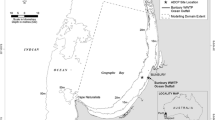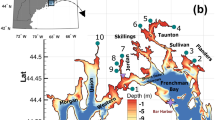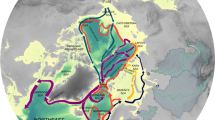Abstract
A three-dimensional hydrodynamic model was created to study the Danshuei River estuarine system and adjacent coastal ocean in Taiwan. The model was verified using measurements of the time-series water surface elevation, tidal current, and salinity from 1999. We conclude that our model is consistent with these observations. Our particle-tracking model was also used to explore the transport of particles released from the Hsin-Hai Bridge, an area that is heavily polluted. The results suggest that it takes a much longer time for the estuary to be flushed out under low freshwater discharge conditions than with high freshwater discharge. We conclude that the northeast and southwest winds minimally impact particle dispersion in the estuary. The particles fail to settle to the bottom in the absence of density-induced circulation. Our model was also used to simulate the ocean outfall at the Bali. Our experimental results suggest that the tidal current dominates the particle trajectories and influences the transport properties in the absence of a wind stress condition. The particles tend to move northeast or southwest along the coast when northeast or southwest winds prevail. Our data suggest that wind-driven currents and tidal currents play important roles in water movement as linked with ocean outfall in the context of the Danshuei River.
Similar content being viewed by others
References
Bilgili, A., Swift, M. R., Lynch, D. R., & Ip, J. T. C. (2003). Modeling hydrodynamics and bed-load transport coarse sediments in the Great Bay Estuary, New Hampshire. Estuarine, Coastal and Shelf Science, 58(4), 937–950.
Bilgili, A., Priehl, J., Lynch, D. R., Smith, K. W., & Swift, M. R. (2005). Estuary/ocean exchange and tidal mixing in a Gulf of Maine Estuary: A Lagrangian modeling study. Estuarine, Coastal Shelf Science, 65(4), 607–624.
Blanton, B. O. (1993). User’s manual for 3-dimensional drogue tracking on a finite element grid with linear finite elements. Technical report, UNC Marine Science, Chapel Hill.
Blumberg, A. F., & Mellor, G. L. (1987). A description of a three-dimensional coastal ocean circulation model. In N. S. Heaps (Ed.), Three-dimensional coastal ocean models, coastal and estuarine science (vol. 4, pp. 1–19). Washington, DC: American Geophysical Union.
Blumberg, A. F., Dunning, D. J., Li, H. H., Heimbuch, D., & Geyer, W. R. (2004). Use of a particle-tracking mode for predicting entrainment at power plants on the Hudson River. Estuaries, 27(3), 515–526.
Burwell, B., Vincent, M., Luther, M., & Galperin, B. (1999). Modeling residence times: Eulerian vs. Lagrangian. In L. Spaulding, & H. L. Butler (Eds.), Proceedings of the sixth international conference of estuarine and coastal modeling (pp. 995–1009). New Orleans.
Casulli, V., & Cheng, R. T. (1992). Semi-implicit finite difference methods for three-dimensional shallow water flow. International Journal for Numerical Methods in Fluids, 15(6), 629–648.
Casulli, V., & Walters, R. V. (2000). An unstructured grid, three-dimensional model based on the shallow water equations. International Journal for Numerical Methods in Fluids, 32(3), 331–348.
Chen, X. J. (2007). A laterally averaged two-dimensional trajectory model for estimating transport time scale in the Alafia River Estuary, Florida. Estuarine, Coastal and Shelf Science, 75(3), 357–370.
Chen, C. S., & Liu, H. (2003). An unstructured grid, finite-volume, three-dimensional, primitive equations ocean model: Application to coastal and estuaries. Journal of Atmospheric and Oceanic Technology, 20(1), 159– 186.
Chen, C. S., Zhu, J., Kang, K. R., Li, H., Ralph, E., Green, S. A., et al. (2002). Cross-frontal transport along the Keweenaw coast in Lake Superior: A Langrangian model study. Dynamics of Atmospheres and Oceans, 36(1–3), 83–102.
Department of Publics Sewerage Systems Report (2001). The environmental monitor program of the sewage outfall in the Danshuei River system during 1998 and 1999. Taiwan: Taipei City Council (in Chinese).
Dimou, K. N., & Adams, E. E. (1993). A random-walk, particle tracking model for well-mixed estuaries and coastal waters. Estuarine, Coastal and Shelf Science, 37(1), 99–110.
Doong, R. A., Sun, Y. C., Liao, P. L., Peng, C. K., & Wu, S. C. (2002). Distribution and fate of organochlorine pesticide residues in sediments from the selected rivers in Taiwan. Chemosphere, 48(2), 237–246.
Elliott, A. J., Wilkins, B. T., & Mansfield, P. (2001). On the dispersal of contaminated milk in coastal waters. Marine Pollution Bulletin, 42(10), 927–934.
Fang, T. H. (2000). Partitioning and behavior of different forms of phosphorus in the Tanshui Estuary and one of its tributaries, northern Taiwan. Estuarine, Coastal and Shelf Science, 50(5), 689–701.
Fang, T. H., & Lin, C. L. (2002). Dissolved and particulate trace metals and their partitioning in a hypoxic estuary: The Tanshui Estuary in northern Taiwan. Estuaries, 25(4A), 598–607.
Gomez-Gesteira, M., Montero, P., Pergo, R., Taboada, J. J., Leitao, P., Ruiz-Villareal, M., et al. (1999). A two-dimensional particle-tracking model for pollution dispersal in A Coruna and Vigo Rias (NW Spain). Oceanologica Acta, 22(2), 167–177.
Gong, W. P., Shen, J., & Jia, J. J. (2008). The impact of human activities on the flushing properties of a semi-enclosed lagoon: Xiaohai, Hainan, China. Marine Environmental Research, 65(1), 62–76.
Hamrick, J. M. (1996). User’s manual for the environmental fluid dynamics computer code. Special report in marine science and ocean engineering, no. 331. Virginia: The College of William and Mary, Virginia Institute of Marine Science.
Hanert, E., Deleersnijder, E., Blaise, S., & Remacle, J. (2007). Capturing the bottom boundary layer in finite element ocean models. Ocean Modelling, 17(2), 153–162.
Harms, I. H., Karcher, M. J., & Dethleff, D. (2000). Modelling Siberian river runoff-implications for contaminant transport in the Artic Ocean. Journal of Marine Systems, 27(1–3), 95–115.
Hsu, M. H., Kuo, A. Y., Kuo, J. T., & Liu, W. C. (1999). Procedure to calibrate and verify numerical models of estuarine hydrodynamics. Journal of Hydraulic Engineering, ASCE, 125(2), 166–182.
Hung, C. C., Gong, G. C., Chen, H. Y., Hsieh, H. L., Santschi, P. H., Wade, T. L., et al. (2007). Relationship between pesticides and organic carbon fractions in sediments of the Danshui River Estuary and adjacent coastal areas of Taiwan. Environmental Pollution, 148(2), 546–554.
Jan, S., Wang, Y. H., Chao, S. Y., & Wang, D. Y. (2001). Development of a nowcast system for the Taiwan Strait (TSNOW): Numerical simulation of barotropic tides. Ocean and Polar Research, 23(3), 195–203.
Jeng, W. L., & Han, B. C. (1994). Sedimentary coprostanol in Kaohsiung harbor and the Tanshui Estuary, Taiwan. Marine Pollution Bulletin, 28(8), 494–499.
Korotenko, K. A., Mamedov, R. M., Kontar, A. E., & Korotenko, L. A. (2004). Particle-tracking method in the approach for prediction of oil slick transport in the sea: Modelling oil pollution resulting from river input. Journal of Marine Systems, 48(1–4), 159–170.
Lane, A., & Prandle, D. (2006). Random-walk particle modeling for estimating bathymetric evolution of an estuary. Estuarine, Coastal and Shelf Science, 68(1–2), 175–187.
Lazzari, M. A., Stevenson, D. K., & Shaw, R. F. (1993). Influence of residual circulation and vertical-distribution of the abundance and horizontal transport of larval Atlantic herring (Clupea-harengus) in a Maine Estuary. Canadian Journal of Fisheries and Aquatic, 50(9), 1879–1890.
Liu, W. C. (2006). Modelling circulation and vertical mixing in estuaries. Proceedings of the Institute if Civil Engineers, Maritime Engineering, 159(2), 67–76.
Liu, W. C., Hsu, M. H., & Kuo, A. Y. (2001). Investigation of long-term transport in Tanshui River Estuary, Taiwan. Journal of Waterway, Port, Coastal and Ocean Engineering, ASCE, 127(2), 61–71.
Liu, W. C., Hsu, M. H., Wu, C. R., Wang, C. F., & Kuo, A. Y. (2004). Modeling salt water intrusion in Tanshui River estuarine system-case-study contrasting now and then. Journal of Hydraulic Engineering, ASCE, 130(9), 849–859.
Liu, W. C., Chang, S. W., Jiann, K. T., Wen, L. S., & Liu, K. K. (2007a). Modelling diagnosis of heavy metal (copper) transport in an estuary. Science and Total Environment, 388(1–3), 234–249.
Liu, W. C., Chen, W. B., Cheng, R. T., Hsu, M. H., & Kuo, A. Y. (2007b). Modeling the influence of river discharge on salt intrusion and residual circulation in Danshuei River Estuary, Taiwan. Continental Shelf Research, 27(7), 900–921.
Liu, W. C., Chen, W. B., Kuo, J. T., & Wu, C. H. (2008a). Numerical determination of residence time and age in a partially mixed estuary using three-dimensional hydrodynamic model. Continental Shelf Research, 28(8), 1068–1088.
Liu, W. C., Chen, W. B., Cheng, R. T., & Hsu, M. H. (2008b). Modelling the impact of wind stress and river discharge on Danshuei River plume. Applied Mathematical Modelling, 32(7), 1255–1280.
Luettich, R. A., Westerink, J. J., & Cheffner, N. W. (1991). ADCIRC: An advanced three-dimensional circulation model for shelves, coasts and estuaries. Coastal Engineering Research Center, U.S. Army Engineers Waterway Experiment Station, Vicksburg, MS Report 1: Theory and Methodology of ADCIRC-2DDI and ADCIRC-3DL.
Murray, A. G., & Gillibrand, P. A. (2006). Modelling salmon lice dispersal in Loch Torridon, Scotland. Marine Pollution Bulletin, 53(1–4), 128–135.
Nakano, M., & Povinec, P. (2003). Oceanic general circulation model for the assessment of the distribution of 137Cs in the world ocean. Deep-Sea Research II, 50(17–21), 2803–2816.
North, E. W., Schlag, Z., Hood, R. R., Li, M., Zhong, L., Gross, T., et al. (2008). Vertical swimming behavior influences the dispersal of simulated oyster larvae in a coupled particle-tracking and hydrodynamic model of Chesapeake Bay. Marine Ecology-Progress Series, 359, 99–115.
Oliveira, A., Fortunato, A. B., & Pinto, L. (2006). Modelling the hydrodynamics and fate of passive and active organisms in the Guadiana Estuary. Estuarine Coastal and Shelf Science, 70(1–2), 76–84.
Perianez, R. (2004). A particle-tracking model for simulating pollutant dispersion in the Strait of Gibraltar. Marine Pollution Bulletin, 49(7–8), 613–623.
Perianez, R. (2009). Environmental modeling in the Gulf of Cadiz: Heavy metal distributions in water and sediments. Science of the Total Environment, 407(10), 3392–3406.
Perianez, R., & Elliott, A. J. (2002). A particle tracking method for simulation the dispersion of non-conservative radionuclides in coastal waters. Journal of Environmental Radioactivity, 58(1), 13–33.
Perianez, R., & Pascual-Granged, A. (2008). Modelling surface radioactive, chemical and oil spills in the Strait of Gibraltar. Computers & Ceosciences, 34(2), 163–180.
Pond, S., & Pickard, G. L. (1998). Introductory dynamical oceanography. Oxford: Butterworth-Heinmann.
Press, W. H., Teukolsky, S. A., & Flanney, B. P. (1994). Numerical recipes in Fortran (2nd ed., p. 280). Cambridge: Cambridge University Press.
Proctor, R., Flather, R. A., & Elliott, A. J. (1994a). Modelling tides and surface drift in the Arabian Gulf: Application to the Gulf oil spill. Continental Shelf Research, 14(5), 531–545.
Proctor, R., Elliott, A. J., & Flather, R. A. (1994b). Forecast and hindcast simulations of the Braer oil spill. Marine Pollution Bulletin, 28(4), 219–229.
Reyns, N. B., Eggleston, D. B., & Luettich, R. A. (2007). Dispersal dynamics of post-larval blue crabs, Callinectes sapidus, within a wind-driven estuary. Fisheries Oceanography, 16(3), 257–272.
Schonfeld, W. (1995). Numerical simulation of the dispersion of artificial radionuclides in the English Channel and the North Sea. Journal of Marine Systems, 6(5–6), 529–544.
Sinha, P. C., Rao, Y. R., Dube, S. K., & Murthy, C. R. (1998). A numerical model for residual circulation and pollutant transport in a tidal estuary (Hooghly) of NE coastal of India. Indian Journal of Marine Sciences, 27(1), 129–137.
Song, Y., & Haidvogel, D. B. (1994). A semi-implicit ocean circulation model using a generalized topography-following coordinate system. Journal of Computational Physics, 115(1), 228–244.
Stentchev, A., & Korotenko, K. (2005). Dispersion processes and transport pattern in the ROFI system of the eastern English Channel derived from a particle-tracking model. Journal of Marine Systems, 25(18), 2294–2304.
Su, S. F. (2006). Variation of tidal current vertical structure at Tanshui Estuary region, Taiwan. M.Sc. thesis, National Sun Yat-Sen University (in Chinese).
Suh, S. W. (2006). A hybrid approach to particle and Eulerian–Langrangian models in the simulation of coastal dispersion. Environmental Modelling & Software, 21(2), 234–242.
Tennekes, H. (1973). The logarithmic wind profile. Journal of the Atmospheric Sciences, 30(2), 234–238.
Thonon, I., Jong, K. D., Park, M. V. D., & Middelkoop, H. (2007). Modelling floodplain sedimentation using particle tracking. Hydrological Processes, 21(11), 1402–1412.
Tilburg, C. E., Houser, L. T., Steppe, C. N., Garvine, R. W., & Epifanio, C. E. (2006). Effects of coastal transport on larval patches: Models and observations. Estuarine, Coastal and Shelf Science, 67(1–2), 145–160.
Tilburg, C. E., Dittel, A. I., & Epifanio, C. E. (2007). Retention of crab larvae in a coastal null zone. Estuarine, Coastal and Shelf Science, 72(4), 570–578.
Umlauf, L., & Buchard, H. (2003). A generic length-scale equation for geophysical turbulence models. Journal of Marine Research, 61(2), 235–265.
Wang, S. D., Shen, Y. M., & Zheng, Y. H. (2005). Two-dimensional numerical simulation for transport and fate of oil spills in seas. Ocean Engineering, 32(13), 1556–1571.
Wang, C. F., Hsu, M. H., Liu, W. C., Hwang, J. S., Wu, J. T., & Kuo, A. Y. (2007). Simulation of water quality and plankton dynamics in the Danshuei River Estuary, Taiwan. Journal of Environmental Science and Health Part A, 42(7), 933–953.
Wu, S. C. (1997). The treatment of domestic sewage by soil. EPA Report: EPA 86-E3G1-09-02, Taiwan (in Chinese).
Zeng, X., Zhao, M., & Dickinson, R. E. (1998). Intercomparison of bulk aerodynamic algorithms for the computation of sea surface fluxes using TOGA COARE and TAO data. Journal of Climate, 11(10), 2628–2644.
Zhang, Y. L., & Baptista, A. M. (2008). SELFE: A semi-implicit Eulerian–Lagrangian finite-element model for cross-scale ocean circulation. Ocean Modelling, 21(3–4), 71–96.
Zhang, Y. L., Baptista, A. M., & Myers, E. P. (2004). A cross-scale model for 3D baroclinic circulation in estuary-plume-shelf systems: I. Formulation and skill assessment. Continental Shelf Research, 24(18), 2187–2214.
Author information
Authors and Affiliations
Corresponding author
Rights and permissions
About this article
Cite this article
Chen, WB., Liu, WC., Kimura, N. et al. Particle release transport in Danshuei River estuarine system and adjacent coastal ocean: a modeling assessment. Environ Monit Assess 168, 407–428 (2010). https://doi.org/10.1007/s10661-009-1123-2
Received:
Accepted:
Published:
Issue Date:
DOI: https://doi.org/10.1007/s10661-009-1123-2




